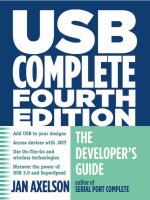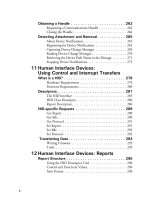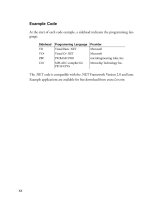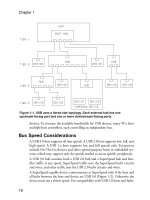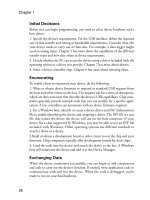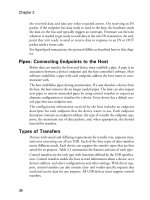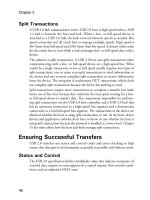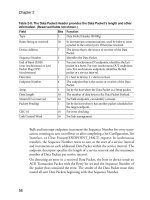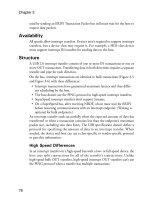USB Complete fourth- P2 pptx
Bạn đang xem bản rút gọn của tài liệu. Xem và tải ngay bản đầy đủ của tài liệu tại đây (123.35 KB, 10 trang )
x
1DVCKPKPIC*CPFNG
Requesting a Communications Handle . . . . . . . . . . . . . . . . 262
Closing the Handle . . . . . . . . . . . . . . . . . . . . . . . . . . . . . . . 264
&GVGEVKPI#VVCEJOGPVCPF4GOQXCN
About Device Notifications . . . . . . . . . . . . . . . . . . . . . . . . . 265
Registering for Device Notifications . . . . . . . . . . . . . . . . . . 265
Capturing Device Change Messages . . . . . . . . . . . . . . . . . . 269
Reading Device Change Messages . . . . . . . . . . . . . . . . . . . . 270
Retrieving the Device Path Name in the Message . . . . . . . . 271
Stopping Device Notifications. . . . . . . . . . . . . . . . . . . . . . . 275
*WOCP+PVGTHCEG&GXKEGU
7UKPI%QPVTQNCPF+PVGTTWRV6TCPUHGTU
9JCVKUC*+&!
Hardware Requirements . . . . . . . . . . . . . . . . . . . . . . . . . . . 279
Firmware Requirements. . . . . . . . . . . . . . . . . . . . . . . . . . . . 280
&GUETKRVQTU
The HID Interface . . . . . . . . . . . . . . . . . . . . . . . . . . . . . . . 285
HID Class Descriptor . . . . . . . . . . . . . . . . . . . . . . . . . . . . . 286
Report Descriptors. . . . . . . . . . . . . . . . . . . . . . . . . . . . . . . . 286
*+&URGEKHKE4GSWGUVU
Get Report . . . . . . . . . . . . . . . . . . . . . . . . . . . . . . . . . . . . . 290
Get Idle . . . . . . . . . . . . . . . . . . . . . . . . . . . . . . . . . . . . . . . . 290
Get Protocol . . . . . . . . . . . . . . . . . . . . . . . . . . . . . . . . . . . . 291
Set Report . . . . . . . . . . . . . . . . . . . . . . . . . . . . . . . . . . . . . . 291
Set Idle . . . . . . . . . . . . . . . . . . . . . . . . . . . . . . . . . . . . . . . . 292
Set Protocol. . . . . . . . . . . . . . . . . . . . . . . . . . . . . . . . . . . . . 292
6TCPUHGTTKPI&CVC
Writing Firmware . . . . . . . . . . . . . . . . . . . . . . . . . . . . . . . . 293
Tools . . . . . . . . . . . . . . . . . . . . . . . . . . . . . . . . . . . . . . . . . . 293
*WOCP+PVGTHCEG&GXKEGU4GRQTVU
4GRQTV5VTWEVWTG
Using the HID Descriptor Tool . . . . . . . . . . . . . . . . . . . . . 296
Control and Data Item Values. . . . . . . . . . . . . . . . . . . . . . . 296
Item Format . . . . . . . . . . . . . . . . . . . . . . . . . . . . . . . . . . . . 296
xi
6JG/CKP+VGO6[RG
Input, Output, and Feature Items. . . . . . . . . . . . . . . . . . . . . 298
Collections . . . . . . . . . . . . . . . . . . . . . . . . . . . . . . . . . . . . . . 302
6JG)NQDCN+VGO6[RG
Identifying the Report . . . . . . . . . . . . . . . . . . . . . . . . . . . . . 303
Describing the Data’s Use. . . . . . . . . . . . . . . . . . . . . . . . . . . 304
Converting Units . . . . . . . . . . . . . . . . . . . . . . . . . . . . . . . . . 306
Converting Raw Data . . . . . . . . . . . . . . . . . . . . . . . . . . . . . . 307
Describing the Data’s Size and Format . . . . . . . . . . . . . . . . . 311
Saving and Restoring Global Items . . . . . . . . . . . . . . . . . . . . 311
6JG.QECN+VGO6[RG
Physical Descriptors . . . . . . . . . . . . . . . . . . . . . . . . . . . . . . . 314
Padding . . . . . . . . . . . . . . . . . . . . . . . . . . . . . . . . . . . . . . . . 314
*WOCP+PVGTHCEG&GXKEGU*QUV#RRNKECVKQP
*++(WPEVKQPU
Requesting Information about the HID . . . . . . . . . . . . . . . . 317
Sending and Receiving Reports. . . . . . . . . . . . . . . . . . . . . . . 317
Providing and Using Report Data. . . . . . . . . . . . . . . . . . . . . 318
Managing HID Communications. . . . . . . . . . . . . . . . . . . . . 319
+FGPVKH[KPIC&GXKEG
Reading the Vendor ID and Product ID. . . . . . . . . . . . . . . . 321
Getting a Pointer to Device Capabilities . . . . . . . . . . . . . . . . 323
Getting the Device’s Capabilities . . . . . . . . . . . . . . . . . . . . . 324
Getting the Capabilities of the Buttons and Values. . . . . . . . 327
5GPFKPICPF4GEGKXKPI4GRQTVU
Sending an Output Report to the Device . . . . . . . . . . . . . . . 328
Reading an Input Report from the Device . . . . . . . . . . . . . . 330
Writing a Feature Report to the Device . . . . . . . . . . . . . . . . 339
Reading a Feature Report from a Device. . . . . . . . . . . . . . . .341
Closing Communications . . . . . . . . . . . . . . . . . . . . . . . . . . . 343
xii
7UKPI9KP75$HQT
8GPFQT&GHKPGF(WPEVKQPU
%CRCDKNKVKGUCPF.KOKVU
Device Requirements. . . . . . . . . . . . . . . . . . . . . . . . . . . . . . 345
Host Requirements . . . . . . . . . . . . . . . . . . . . . . . . . . . . . . . 346
Device Firmware . . . . . . . . . . . . . . . . . . . . . . . . . . . . . . . . . 346
Assigning the WinUSB Driver. . . . . . . . . . . . . . . . . . . . . . . 349
#EEGUUKPIVJG&GXKEG
Obtaining a WinUSB Handle . . . . . . . . . . . . . . . . . . . . . . . 350
Requesting an Interface Descriptor . . . . . . . . . . . . . . . . . . . 352
Identifying the Endpoints . . . . . . . . . . . . . . . . . . . . . . . . . . 354
Setting Pipe Policies. . . . . . . . . . . . . . . . . . . . . . . . . . . . . . . 359
Writing Data via Bulk and Interrupt Transfers . . . . . . . . . . 364
Reading Data via Bulk and Interrupt Transfers . . . . . . . . . . 366
Using Vendor-defined Control Transfers. . . . . . . . . . . . . . . 368
Closing Communications . . . . . . . . . . . . . . . . . . . . . . . . . . 371
#NN#DQWV*WDU
75$
The Hub Repeater. . . . . . . . . . . . . . . . . . . . . . . . . . . . . . . . 376
The Transaction Translator . . . . . . . . . . . . . . . . . . . . . . . . . 377
The Hub Controller . . . . . . . . . . . . . . . . . . . . . . . . . . . . . . 383
Speed. . . . . . . . . . . . . . . . . . . . . . . . . . . . . . . . . . . . . . . . . . 383
Maintaining Active Links . . . . . . . . . . . . . . . . . . . . . . . . . . 385
75$
Bus Speeds. . . . . . . . . . . . . . . . . . . . . . . . . . . . . . . . . . . . . . 386
Components . . . . . . . . . . . . . . . . . . . . . . . . . . . . . . . . . . . . 386
Managing Traffic. . . . . . . . . . . . . . . . . . . . . . . . . . . . . . . . . 387
6JG*WD%NCUU
Hub Descriptors . . . . . . . . . . . . . . . . . . . . . . . . . . . . . . . . . 388
Hub Class Requests . . . . . . . . . . . . . . . . . . . . . . . . . . . . . . . 388
Port Indicators. . . . . . . . . . . . . . . . . . . . . . . . . . . . . . . . . . . 388
xiii
/CPCIKPI2QYGT
2QYGT1RVKQPU
Voltages . . . . . . . . . . . . . . . . . . . . . . . . . . . . . . . . . . . . . . . . 390
Using Bus Power . . . . . . . . . . . . . . . . . . . . . . . . . . . . . . . . . 390
Power Needs. . . . . . . . . . . . . . . . . . . . . . . . . . . . . . . . . . . . . 392
Informing the Host. . . . . . . . . . . . . . . . . . . . . . . . . . . . . . . . 393
Battery Charging . . . . . . . . . . . . . . . . . . . . . . . . . . . . . . . . . 393
*WD2QYGT
Power Sources. . . . . . . . . . . . . . . . . . . . . . . . . . . . . . . . . . . . 396
Over-current Protection . . . . . . . . . . . . . . . . . . . . . . . . . . . . 397
Power Switching. . . . . . . . . . . . . . . . . . . . . . . . . . . . . . . . . . 399
5CXKPI2QYGT
USB 2.0 Link Power Management . . . . . . . . . . . . . . . . . . . . 399
Suspend State . . . . . . . . . . . . . . . . . . . . . . . . . . . . . . . . . . . . 400
Sleep State . . . . . . . . . . . . . . . . . . . . . . . . . . . . . . . . . . . . . . 401
SuperSpeed Power Management. . . . . . . . . . . . . . . . . . . . . . 402
Power Management under Windows . . . . . . . . . . . . . . . . . . 407
6GUVKPICPF&GDWIIKPI
6QQNU
Hardware Protocol Analyzers . . . . . . . . . . . . . . . . . . . . . . . . 410
Software Protocol Analyzers . . . . . . . . . . . . . . . . . . . . . . . . . 412
Traffic Generators. . . . . . . . . . . . . . . . . . . . . . . . . . . . . . . . . 414
6GUVKPI
Compliance . . . . . . . . . . . . . . . . . . . . . . . . . . . . . . . . . . . . . 415
Windows Logo . . . . . . . . . . . . . . . . . . . . . . . . . . . . . . . . . . . 422
2CEMGVUQPVJG$WU
75$
Low Speed and Full Speed Bus States . . . . . . . . . . . . . . . . . . 425
High Speed Bus States . . . . . . . . . . . . . . . . . . . . . . . . . . . . .428
Data Encoding . . . . . . . . . . . . . . . . . . . . . . . . . . . . . . . . . . . 430
Staying Synchronized . . . . . . . . . . . . . . . . . . . . . . . . . . . . . . 431
Timing Accuracy . . . . . . . . . . . . . . . . . . . . . . . . . . . . . . . . . 432
Packet Format. . . . . . . . . . . . . . . . . . . . . . . . . . . . . . . . . . . . 433
Inter-Packet Delay . . . . . . . . . . . . . . . . . . . . . . . . . . . . . . . . 434
Test Modes. . . . . . . . . . . . . . . . . . . . . . . . . . . . . . . . . . . . . . 435
xiv
5WRGT5RGGF
Data Scrambling . . . . . . . . . . . . . . . . . . . . . . . . . . . . . . . . . 436
Encoding. . . . . . . . . . . . . . . . . . . . . . . . . . . . . . . . . . . . . . . 436
Link Layer . . . . . . . . . . . . . . . . . . . . . . . . . . . . . . . . . . . . . . 437
Reset . . . . . . . . . . . . . . . . . . . . . . . . . . . . . . . . . . . . . . . . . . 438
6JG'NGEVTKECNCPF/GEJCPKECN+PVGTHCEG
75$6TCPUEGKXGTU
Cable Segments . . . . . . . . . . . . . . . . . . . . . . . . . . . . . . . . . . 440
Low- and Full-Speed Transceivers . . . . . . . . . . . . . . . . . . . . 441
High-speed Transceivers . . . . . . . . . . . . . . . . . . . . . . . . . . . 444
Signal Voltages . . . . . . . . . . . . . . . . . . . . . . . . . . . . . . . . . . 448
75$%CDNGU
Conductors . . . . . . . . . . . . . . . . . . . . . . . . . . . . . . . . . . . . . 450
Connectors . . . . . . . . . . . . . . . . . . . . . . . . . . . . . . . . . . . . . 451
Detachable and Captive Cables . . . . . . . . . . . . . . . . . . . . . . 453
Cable Length. . . . . . . . . . . . . . . . . . . . . . . . . . . . . . . . . . . . 454
Bus Length . . . . . . . . . . . . . . . . . . . . . . . . . . . . . . . . . . . . . 455
Inter-Chip Connections. . . . . . . . . . . . . . . . . . . . . . . . . . . . 455
75$
Transmitters and Receivers . . . . . . . . . . . . . . . . . . . . . . . . . 457
Cables . . . . . . . . . . . . . . . . . . . . . . . . . . . . . . . . . . . . . . . . . 457
'PUWTKPI5KIPCN3WCNKV[
Sources of Noise . . . . . . . . . . . . . . . . . . . . . . . . . . . . . . . . . 462
Balanced Lines. . . . . . . . . . . . . . . . . . . . . . . . . . . . . . . . . . . 462
Twisted Pairs . . . . . . . . . . . . . . . . . . . . . . . . . . . . . . . . . . . . 463
Shielding . . . . . . . . . . . . . . . . . . . . . . . . . . . . . . . . . . . . . . . 464
Edge Rates. . . . . . . . . . . . . . . . . . . . . . . . . . . . . . . . . . . . . . 464
Isolated Interfaces . . . . . . . . . . . . . . . . . . . . . . . . . . . . . . . . 465
)QKPI9KTGNGUU
Certified Wireless USB . . . . . . . . . . . . . . . . . . . . . . . . . . . . 466
Cypress WirelessUSB. . . . . . . . . . . . . . . . . . . . . . . . . . . . . . 466
Other Options. . . . . . . . . . . . . . . . . . . . . . . . . . . . . . . . . . . 468
xv
*QUVUHQT'ODGFFGF5[UVGOU
75$1P6JG)Q
Capabilities and Limits . . . . . . . . . . . . . . . . . . . . . . . . . . . . . 472
The OTG Connector . . . . . . . . . . . . . . . . . . . . . . . . . . . . . . 472
The A-Device and B-Device . . . . . . . . . . . . . . . . . . . . . . . . . 472
Requirements for an OTG Device . . . . . . . . . . . . . . . . . . . . 473
The OTG Descriptor . . . . . . . . . . . . . . . . . . . . . . . . . . . . . . 479
Feature Codes for HNP . . . . . . . . . . . . . . . . . . . . . . . . . . . .480
1VJGT*QUV1RVKQPU
Requirements . . . . . . . . . . . . . . . . . . . . . . . . . . . . . . . . . . . . 481
Device Ports . . . . . . . . . . . . . . . . . . . . . . . . . . . . . . . . . . . . . 481
%QPVTQNNGT%JKRU
Microcontrollers . . . . . . . . . . . . . . . . . . . . . . . . . . . . . . . . . . 483
Interface Chips . . . . . . . . . . . . . . . . . . . . . . . . . . . . . . . . . . . 484
+PFGZ
xvii
Introduction
This book is for developers who are involved with designing or programming
devices that use the Universal Serial Bus (USB) interface. If you are a hardware
designer, if you write firmware that resides inside USB devices, or if you write
applications that communicate with devices, this book is for you.
USB is versatile enough to serve a multitude of device functions. Familiar USB
peripherals include mice, keyboards, drives, printers, speakers, and cameras.
USB is also suitable for data-acquisition units, control systems, and other
devices with specialized functions, including one-of-a-kind designs. The right
choices of device hardware, software drivers and development tools and tech-
niques can ease the path to designing devices that perform their functions with-
out error or user aggravation. This book will guide you along the way.
9JCVŏU+PUKFG
The USB specifications are the ultimate authority on the USB interface, but by
design they omit advice, example code, and other information that applies to
specific device hardware, software, and other tools and products. This book
xviii
bridges the gap between the specifications and real-world designs and will save
you time and trouble when developing devices and the software to access them.
These are some of the questions this book answers:
• How do USB devices communicate? I don’t attempt to restate everything in
the USB specifications. Instead, my focus is on what you need to know to
develop devices that communicate efficiently and reliably.
• How can I decide if my device should use a USB interface? Find out whether
your device should use USB or another interface. If the choice is USB,
you’ll learn how to decide which of USB’s four speeds—including USB
3.0’s SuperSpeed—and which of USB’s four transfer types are appropriate
for your application.
• What controller chip should my device use? Every USB device contains an
intelligent controller to manage USB communications. Dozens of silicon
providers offer controller chips with different architectures and abilities.
This book will help you select a controller based on your project’s needs,
your budget, and your preferences for chip architecture, programming lan-
guages, and tools.
• How can applications communicate with my devices? On a PC, an application
accesses a USB device by communicating with a driver the operating system
has assigned to the device. You’ll learn if your device can use a class driver
provided by the host’s operating system. For devices that don’t fit a sup-
ported class, you can explore options such as Microsoft’s WinUSB driver,
other generic drivers, and custom drivers. Example code shows how to
detect and communicate with devices from Visual Basic and Visual C#
applications.
• What firmware does my device need to support USB communications? Find out
how to write firmware that enables your device to respond to USB requests
and events and exchange data for any purpose.
• Does my device need its own power supply? The USB interface can provide
power to devices, including charging current for battery-powered devices.
Learn how to determine if a design can obtain all of its power from the bus,
how to meet USB’s requirements for conserving power, and how to charge
battery-powered devices from the bus.
• How can I implement wireless communications? The Wireless USB specifica-
tion defines a way for USB devices to communicate without wires. Other
industry standards and vendor technologies offer additional options. Learn
which technology is right for your device.
xix
• How can my device access other USB devices? Find out how to develop a host
for an embedded system or a USB On-The-Go device that can function as
both a USB device and a limited-capability host that accesses other USB
devices.
• How can I ensure reliable communications? All devices must respond to
requests and other events on the USB port. The host computer must detect
attached devices, locate appropriate drivers, and exchange data with the
devices. This book provides tips, example code, and information about
debugging software and hardware to help with these tasks.
To understand the material in the book, it’s helpful to have some experience
with digital logic, application programming for PCs and writing embedded
code for peripherals. You don’t have to know anything about USB.
9JCVŏU0GY
The core of USB has remained much the same since the release of USB 1.0 in
1996. But the interface has expanded to support faster bus speeds, improved
power management, more device classes, wireless communications, dual-role
devices (device and host), and more. Plus, new and improved chips and devel-
opment tools have eased the task of developing devices and software to access
them.
This edition is revised and updated throughout. All new in the Fourth Edition
is an introduction to USB 3.0 and the SuperSpeed bus. You’ll also learn how to
use Microsoft’s WinUSB driver to access devices that perform vendor-specific
functions. Topics with major updates include device-controller chips, technolo-
gies for wireless USB communications, protocols for conserving power, and
USB device classes.
I provide example code for applications in both Visual Basic and Visual C#. For
device firmware, I discuss using both microengineering Labs’ PICBASIC
PRO™ and Microchip Technology’s MPLAB® C compiler.
7RFCVGUCPF/QTG
To find out more about developing USB devices and the software that commu-
nicates with them, I invite you to visit my USB Central page at www.Lvr.com.
You’ll find code examples and links to articles, products, tools, and other infor-
mation related to developing USB devices.
Corrections and updates to the book will also be available at www.Lvr.com. If
you find an error, please let me know.
